 |
It's a sad  but oft-repeated tale in classical music – so many of those now hailed as visionary geniuses died thinking themselves a failure or at best only a modest success. Thus, Bach's reputation was provincial, Beethoven was marginalized, Mahler a conductor's whim. but oft-repeated tale in classical music – so many of those now hailed as visionary geniuses died thinking themselves a failure or at best only a modest success. Thus, Bach's reputation was provincial, Beethoven was marginalized, Mahler a conductor's whim.  Even sadder is when a composer like Mozart or Schubert dies far too soon, unaware that within his normal lifetime he would have reaped extraordinary fame and fortune from his early work. When Georges Bizet died in June 1875 at age 37, none of his prior efforts had attained either commercial success or artistic recognition and he had no inkling that his recent opera Carmen, which had reaped blisteringly negative reviews and was playing to near-empty houses, would soon become acclaimed by both critics and public as one of greatest operas ever written – and the most popular of them all. Even sadder is when a composer like Mozart or Schubert dies far too soon, unaware that within his normal lifetime he would have reaped extraordinary fame and fortune from his early work. When Georges Bizet died in June 1875 at age 37, none of his prior efforts had attained either commercial success or artistic recognition and he had no inkling that his recent opera Carmen, which had reaped blisteringly negative reviews and was playing to near-empty houses, would soon become acclaimed by both critics and public as one of greatest operas ever written – and the most popular of them all.
There had been few clues to the ultimate success of Carmen, either in the career of its composer or along the route to its first production.
Pushed into music by his parents and taught at first by his father, Bizet boded to become one of the finest pianists of his time. He won the Prix de Rome and his playing was acclaimed by Berlioz and Liszt. Yet, Bizet rejected concertizing to focus on composition, a wise decision at the time, when the former era of composer/pianists had ceded to an age of compartmentalization in which pieces by performers were dismissed as trivial indulgences. While know nothing of Bizet's skill as a keyboard performer beyond anecdotal praises, we do have extraordinary proof of his early writing talent – his astounding Symphony in C, written at age 17 but only discovered through a biographer's research and given its first hearing in 1935.

Georges Bizet |
Combining the gossamer grace of Mendelssohn, lyric charm of Schubert and vigor of Haydn with a touch of academia (incorporating a fugue), foreign intrigue (a "Scottish" trio) and nostalgia (a haunting, sinuous andante theme), it soon became one of the most frequently programmed and recorded symphonies, even though Bizet himself never heard it or had reason to believe anyone else ever would.
Through no fault of his own, Bizet had been in the wrong place at the wrong time. French musical life of his era held little future for native orchestral composers. As its name suggested, the only permanent orchestra – the Société des Concerts du Conservatoire – was supported by academics and favored a repertoire of established classics. New works were introduced only by hiring one's own ensemble, a prohibitively expensive venture without sponsors or prior fame. Opera, too, presented limited opportunities. Of the two major houses, the Opéra favored foreign works. The only alternative was the Opéra-Comique, which was mired in formulas of the past suitable for family entertainment – sentimental plots, rigid morality, edifying characters and happy endings (usually a marriage of the tenor and soprano leads). It was estimated that one-fifth of its audience was bridal couples and their families seeking affirmation of their joy and values, hardly a venue apt to welcome a lurid melodrama of seething sensuality, betrayal and murder.
Among Bizet's prior operas, one seemed especially suited to the expectations of the Opéra-Comique management and audience. His 1866 La Jolie Fille de Perth, loosely based on the Walter Scott novel, was hobbled by a weak libretto and a score that tended to emulate the familiar affable style of Gounod, including a lovely wistful danse bohemienne. Heard today, even in a committed realization like the Pretre-led 1985 EMI recording, it seems pleasant but bland, without any particular marks of distinction or interest. At first blush his 1862 Pêcheurs de perles, set in Ceylon, where a king and his former rival battle for the forbidden love of a priestess, suggested a heated outlook. Indeed, Berlioz had hailed it as "expressive, full of fire and of a rich coloration." Yet most of its passion and exotica was submerged in rather conventional-sounding arias and choruses. Bizet's personal longings, while closer to the latter, looked well beyond them both. In his only published article, he had outlined his personal creed, in which he decried the systemization of art and criticism as discouraging innovation and referred to his free will and complete independence. In letters, he stated: "My sensual nature lets itself be gripped by music that is at once facile, lazy, amorous, lascivious and passionate. … I am an eclectic." With perhaps wishful thinking, he proclaimed: "The old school of ump-pa-pa, roulades and lies is dead." He admired Verdi, whose "passionate, violent and at time brutal temperament endows art with a powerful, living work full of gold, mud, bile and blood." He embraced Wagner, too: "Make me laugh or cry. Paint me love, hate, fanaticism, crime. Charm me, stun me, transport me." Clearly, his frustration with the conventions of French theatre led him to gaze toward distant horizons.
The vehicle for Bizet's realization of his ideals turned out to be a 1845 novella by Prosper Mérimée,
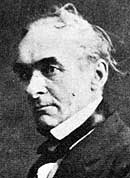
Prosper Mérimée |
narrated by a French archeologist in Andalusia to whom Don José Navarro, a notorious brigand awaiting his execution, relates the tale of his fatal encounter with the gypsy Carmencita. While guarding her as a young corporal, she tempts him into letting her escape for which he is demoted and imprisoned. She arranges for his getaway and rewards him with an unforgettable night of abandon. He kills a lieutenant in a jealous fight over her affections, joins her in smuggling, kills her evil husband Garcia, murders her when she befriends a picador Lucas and demands to be free, and finally turns himself in. Curiously, though, this tale of unbridled lust and brutality is diluted by numerous scholarly footnotes and a lengthy concluding chapter detailing gypsy history, language and culture. The thick overlay of intellectual detachment may have enabled readers to legitimize their vicarious attraction to such an earthy and vivid account.
Although Bizet had never set foot in Spain, he apparently became intrigued by a book, Echos d'Espagne, which he borrowed from the Conservatoire library, and wanted to adapt the Mérimée tale for an opera libretto. The director of the Opéra-Comique had been impressed by Bizet's previous slice of exotica, the one-act oriental fantasy Djamileh (1872), and paired the composer with an established team of librettists who had provided three hugely successful Offenbach operettas – Ludovic Halévy, who wrote the lyrics, and Henri Meilhac, who wrote the prose dialogue. (Opéra-Comique productions typically consisted of musical numbers separated by spoken dialogue, in the fashion of most Broadway shows.) The actual genesis of the new opera is unclear, as Bizet's diaries were heavily censored after his death by Halévy (a cousin of Bizet's wife who sought to protect her privacy), but apparently all three creators were in close contact and Bizet had a heavy hand in preparing the text, even going so far as to substitute his own words for a key aria, the Habenera.
The adaptation of the Mérimée novella focused on its two main characters – Carmen, steadfast in her personal moral code of self-reliance, freedom, shifting loyalty and fatalism, and Don José, buffeted by blind passion.
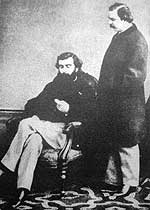
Bizet's lyricists
Meilhac and Halévy |
Yet, to temper the story to meet audience expectations, they simplified the structure into a linear narrative progression, converted Don José from an unsavory bandit to a naïf, boosted Carmen's sensual drive, eliminated her evil husband altogether, promoted the picador Lucas to a bullfighter rival Escamillo, and added a wholly new character – Michaëla, Don José's loyal virginal hometown sweetheart – as a foil to Carmen's coarse savvy and flighty wanderlust. While commercially astute, the changes only barely edged the story toward respectability.
The resulting adaptation cast the story into four acts. In Act I, set in a square between a cigarette factory and a military guardhouse, Michaëla brings Don José a letter from his mother, Carmen is arrested after a factory fight, and she lures Don José into letting her escape. Act II finds Carmen and her two friends Frasquita and Mercédès in Lillas Pastia's tavern, where they toast the triumphant toreador Escamillo, plan their next exploits and convince Don José to desert his regiment and join them. Act III, set in the smugglers' mountain lair, finds Don José clinging to Carmen's fading affection, fighting with Escamillo, and departing with Michaëla, who brings news that his mother is dying. Act IV, set outside the bullring, begins with a gala procession to accompany Escamillo to his next triumph, but Carmen remains behind and spurns the enraged pleas of a desperate Don José, who murders her as the crowd emerges with their bullfighting hero. The producers tried to sweeten the ending by first trying to eliminate the climactic murder and then suggesting a cathartic ballet. Having finally grasped the scandalous nature of the opera about to shame his theatre, one of the two producers resigned.
The new work soon was praised by such disparate composers (and presumed experts on such matters) as Wagner, Brahms and Tchaikovsky (who, with amazing foresight, predicted it would become the most popular of all operas within a decade), as would Debussy, Busoni and Stravinsky in the next generation. Yet at the time Carmen seemed doomed by critics who used it as a mirror of their own outlooks and as a challenge to their stature as upholders of artistic decorum. Apparently swayed by moral outrage, some published their condemnations even before the premiere, having never even heard it. Nearly all united in moral propriety to condemn the story generally, and Carmen's sexuality in particular, as scandalous. Typical was Félix Clément, for whom Bizet's music "could not redeem the shame of such a subject, the like of which has never in two centuries dishonored a stage dedicated to the delicate pleasures and sentiments of polite society." Only Michaëla's role evaded censure, although nowadays it seems insipid. Nor did the music itself escape unscathed; critics slammed "the exaggerated competition by the instruments against the voices," orchestration "so broken up and elaborated as to confuse by its fragmentary effect," and even the wonderful prelude as "curiously chromatic, not to say ugly."
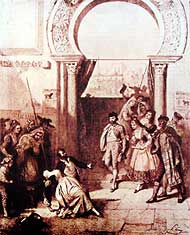
Poster for the premiere run
at the Opéra-Comique |
One critic went so far as to condemn the vibrant score as having "a complete absence of light – music dwelling from start to finish in the limbo of grayness." As Susan McClary notes, the critical reaction was a matter of perception – it would have been just as easy to laud Bizet's blending of styles as to slam his clash of influences. All this now seems utterly incredible – and ironic in light of the relatively benign Halévy/Meilhac adaptation of the far grittier original. Yet at the time the standards of the Opéra-Comique were not to be taken lightly.
In fairness, much of the critics' aversion stemmed from their general distaste for innovation, with which Carmen is replete. In retrospect, we now recognize that its immediate impact was to challenge and break through the barriers of French tradition and forge the way for Debussy and others to revitalize an art that was becoming derivative and static. Thus, Paul Henry Lang salutes its naturalism as a reaction to the formulas of romanticism that were becoming artificial and tiresome. Harold Schonberg sees it as the first step toward verismo, which would revitalize opera with contemporary characters true to life, their declamation emboldened with frankly emotive expression. McClary suggests that the key to the entire opera is its embedded musical tensions that constantly threaten to overwhelm the narrative frame. She notes, though, that Carmen's emotions were still tempered with French gentility, much in the manner of Mérimée's narrator. Ellen Bleiler suggests a more mundane reason for the critical lambasting – the producers didn't pay the customary bribes. (She also suggests that their hypocrisy of having mistresses of their own while condemning the "immoral" plot of Carmen should be viewed in the rationale of the time in which lives were compartmentalized – sordid behavior was tolerated so long as it was kept private.)
Admittedly, Bizet gave defenders of tradition a lot of ammunition from the very outset. The tripartite prelude ends by pounding out two "forbidden" chords (unison, repeated augmented seconds) that resolve only into a diminished seventh and then silence. The traditionally immobile and uniform chorus is used as an integral part of the action, including an intricately-scored and -staged extended fight. But to Opéra-Comique audiences, all this undoubtedly paled compared to the shock on their stage of a free-living slut and her brutal murder.
 The enduring appeal and formidable strength of Carmen lie equally in its story, lyrics and music. McClary presents a fascinating analysis of the exotic elements of the Mérimée story that Meilhac wisely preserved. In her view, in a desire for liberation from the repression of the Church, Europeans at the time were drawn to the allure of a utopian oriental fantasy world of passion and intrigue. Gypsies, too, viewed as decadent and criminal, offered a vicarious escape from social strictures, even while presenting a threat to the social order. McClary further suggests that the plot of a licentious woman ruining a good man may have had special resonance as symbolizing the ravages of venereal disease. (The character of Carmen may have been modeled in part on Céleste Vanaud, a passionate but benevolent prostitute turned dancer and author whom Bizet knew.)
The lyrics are often uncommonly inspired. Carmen's entrance crystallizes her character with startling efficiency – in response to the entreaties of an entire chorus of horny young men she sings:
Quand je vous aimerai?
Ma foi, je ne sais pas!
Peut-être jamais, peut-être domain!
Mais pas aujourd'hui, c'est certain! |
When will I love you?
Heavens, I don't know!
Perhaps never, perhaps tomorrow!
But not today - that's for sure! |
Or again, in the refrain to the Habanera (for which Bizet wrote the text):
L'amour est enfant de bohème,
Il n'a jamais, jamais connu de loi,
Si tu ne m'aimes pas, je t'aime;
Si je t'aime, prends garde à toi. |
Love is a gypsy child,
It never, ever knew any law,
If you don't love me, I love you;
If I love you, be careful. |
The sheer musicality of the words can be wondrous as well. Consider the rhythmic sibilance of the opening chorus:
Sur la place, chacun passe,
Chacun vient, chacun va. |
Through the square, everyone passes,
Everyone comes, everyone goes. |
Indeed, as telling proof of the importance of the text, the very next line makes sense only musically:
| Drôles de gens que ces gens-là! |
Funny are men like those men there. |
Above all else, it is Bizet's music that makes an enduring impression, even when divorced from the text in one of the many posthumous orchestral suites or arrangements prepared by others. While often admired for its evocative moods, efficient orchestration and profuse melodies, Bizet's music is essentially traditional in form, adhering to the convention of self-contained set pieces and bravura display vehicles for all four of the lead singers. And while consistently evoking the exotic (to Parisians) setting, Bizet's work has little direct connection to Spain or authentic Spanish music. Indeed, the only genuine links are the first act Habanera, which Bizet mistook for a folk song but which closely follows a piece by the Spanish-American Sebastián Yradier, and the final entr'acte, taken from a polo (Andalusian song) by Manuel García.
While certainly not motivic in the Wagnerian sense, snatches of melody associated with the characters provide ironic commentary to the narrative developments, as when a wisp of the "Toreador Song" lingers as a harbinger of Carmen's shifting affections at the end of Act III. A portentious "fate" motif pervades the story as a constant reminder of Carmen's guiding force. The scoring helps to emphasize character traits – generally lush and old-fashioned for Michaëla, brash for Escamillo and sweet, flighty chirping for Carmen's two friends Mercédès and Frasquita, even when they deliver a dire message in Act IV, thus suggesting that they're irredeemably vacuous. The end is enormously enhanced by setting the culmination of the tragedy to a dirge version of the "Toreador Song," its bravery mocking Don José's misplaced passion, and by having the orchestra complete Don José's final broken line with an ironic romantic swell and then two somber chords.
The sheer abundance of musical highlights is astounding enough. Even more remarkable is their extraordinary quality. Here's a brief outline, which may prove useful in fleshing out the story and references to be noted later:
- ACT I:
- Prelude – By bracketing the proud theme of the "Toreador Song" with a brisk, festive, carefree march and then boldly plunging into a minor fate motif, Bizet wastes no time in setting the scene, prefiguring the story and giving notice of his own bold approach.
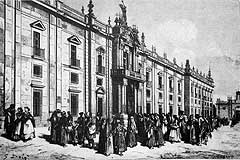
The Seville tobacco factory
Engraving by Gustave Doré |
- "Sur la place" – Amid an opening chorus of passersby, Micaëla, seeking Don José, banters with Morales, captain of the guard, in a recitative (one of the few Bizet intended).
- "Nous marchons la tête haute" – A children's chorus marches in and out, mimicking, and gently mocking, the military structure in which the opera is immersed.
- "La cloche a sonné" – Ardent suitors and cigarette girls join in a gorgeous chorus, whose swirling vocal lines ("la fumée") emulate rising smoke. The men demand Carmen, who teasingly puts them off.
- "L'amour est un oiseau rebelle" (Habanera) – In Carmen's first aria, she portrays herself as an unfettered bird, throws a flower to Don José and then returns to the factory with the girls.
- "Parlez-moi de ma mère" – In a long, sweet duet, Michaëla gives Don José a letter from his mother that kindles his memories and prompts a pledge to make her proud.
- "Au secours!" – A divided women's chorus depicts a fight in the factory between defenders and accusers of Carmen.
- "Près des ramparts de Séville" (Séguidille) – With an exquistely seductive song, Carmen lures Don José to free her so they can meet at Lillas Pastia's tavern.
- Finale – In another of Bizet's few recitatives, Carmen arranges to shove Don José, and escapes, to the crowd's delight.
- ACT II:
- Entr'acte – A playful bassoon tune sets a rustic mood.
- "Les tringles des sistres tintaient" (Chanson bohème) – Carmen's third big aria, an increasingly wild gypsy dance with her friends Frasquita and Mercédès.

A gypsy singing
Engraving by Gustave Doré |
- "Vivat! Vivat le torero!" – The crowd welcomes the toreador Escamillo.
- "Votre toast" (the Toreador Song) – To stroke his star's ego Bizet provided this at the last moment and disparaged it as "ordure" (filth), but Escamillo's heroic song describing a bullfight, with its "Toreador en garde" refrain, is among the most popular arias ever written.
- "Nous avons en tête une affaire" (Quintet) – The smugglers plan new exploits, but Carmen declines to join them.
- "Halte-là" – Don José sings the entr'acte tune a capella as he approaches the gypsy camp, at first off-stage, concluding as he arrives.
- Finale – The last 15 minutes of Act II is continuous music, highlighted by:
- "Je vais danser en votre honneur" – As Carmen entertains Don José with a wordless song, a counterpoint of bugles sounds retreat; he prepares to leave but she scornfully accuses him of not loving her.
- "La fleur que tu m'avais jetée" – Don José tenderly recalls the effect of the flower Carmen threw to him and professes his love.
- "Là-bas, là-bas dans la montagne" – Carmen lures Don José to follow her into the mountains, but he adamantly refuses.
- "Bel officier" – Lieutenant Zuñiga has come searching for Don José; they fight and are disarmed by the gypsies; in mock politeness, Carmen invites Zuñiga to join them.
- "Ah! Le mot n'est pas gallant" – The act concludes with a stirring ode to the glories of liberty, although Don José has lost his.
- ACT III:
- Entr'acte – Flute and harp pace a lovely bucolic prelude.
- "Écoute, campagnon" – The smugglers enter a rocky glen to an eerie march, tinged with dissonance.
- "Mêlons! Coupons!" (Card scene trio) – Carmen, Mercédès and Frasquita read their fortunes in cards - they chirp with good news, but Carmen somberly keeps turning up symbols of death.
- "Quant au douanier" – The gypsies leave, singing a complex ensemble taunt of customs agents.
- "Je dis que rien ne m'épouvante" – Michaëla appears and sings a ravishingly lovely air in which she laments what Don José has become.

The toréador
Engraving by Gustave Doré |
- Finale – The 12-minute Third Act finale is the only musical portion of Carmen that's not intensely melodic, but intentionally so in light of its narrative purpose; confrontations among the major characters amid shreds of earlier music subside only with Micaëla's revelation that Don José's mother is dying and he reluctantly departs.
- ACT IV:
- For his dénoument, Bizet's final act is radically different from the prior three. A relatively brief 17 minutes, the entire act is continuous music. It begins with a Spanish-sounding entr'acte whose bright rhythm subsides into a sad and ultimately wistful mood. As a foil to the grim melodrama to come, crowds and merchants outside the bullring celebrate with a festive and hearty chorus ("A deux cuartos") and then a parade of local officials and matadors bears Escamillo into the arena ("Les voici") after he and Carmen profess their love. Mercédès and Frasquita warn Carmen and then leave her alone to face Don José ("C'est toi? C'est moi."). Refusing his entreaties to renew their ardor, she fiercely and proudly insists upon her freedom. As the crowd celebrates Escamillo's triumph and pours out of the arena, Don José stabs Carmen and in the opera's final lines proclaims to the crowd:
Vous pouvez m'arrêter – c'est moi qui l'ai tuée.
O Carmen! Ma Carmen adorée. |
You can arrest me - it's I who killed her.
O Carmen! My adored Carmen. |
Halévy recorded his impressions of the opening night in a letter the next day – the first act was acclaimed with enthusiastic applause and Bizet was called to the stage, but after the "Toreador Song," as Carmen departed increasingly from traditional Opéra-Comique form, the audience turned cold and applauded only Michaëla's classically-restrained Act III air. The scheduled run of 48 performances would be completed but after the first few nights interest waned. Even so, early receipts had been respectable enough, and the management apparently saw sufficient potential, to sign Bizet to a contract for another opera.

Galli-Marié, the first Carmen |
Yet Bizet was depressed over the doubtful future of Carmen and died after its 31st performance. Astonishingly for an opera steeped in fatalism, Marie Célestine Galli-Marié, singing the role of Carmen, collapsed on stage that very night.
The day before his death, Bizet had signed a contract to have Carmen produced in Vienna that fall. Carmen's ultimate success stemmed from that production, although Bizet barely would have recognized it – not only was the mounting lavish and the second act bloated with a lengthy ballet (later shifted to Act IV) based on pieces from his Jolie Fille de Perth and incidental music to L'Arlesienne, but all dialogue was replaced with sung recitative composed by Bizet's friend Ernest Guiraud, in which much of the background detail, motivation and humorous relief is lost, the plot and characters simplified, and the dramatic confrontations drained of impact as stylized song rather than acted text. Thus, Michaëla, who at great risk twice brings Don José his mother's messages, seems little more than a mindless messenger, since we no longer know why – the original dialog, though, tells us that she was orphaned and taken in by his mother, to whom she owes her own life. The pacing, too, becomes impaired, as the music, and especially the through-composed finales, lose much of their prominence and dramatic weight in comparison to the surrounding speech. But while not how its creators had conceived their work, it was the grand opera version that was published and is the form in which we have come to know Carmen.
Within three years, traveling troupes were presenting Carmen in America (albeit in an Italian translation), England, Germany, Italy, Russia and the French provinces. Perhaps still stinging from the rebukes it suffered from the premiere, the Opéra-Comique didn't mount a revival until 1883 when it faced a different storm of criticism, this time over the puerility of its shoddy sets, static chorus, classical ballet, aristocratic costumes and even bland singing, as the producers had shunned Galli-Marié, who had created the role and for whom Bizet had customized it (and upon whose overtly realistic and earthy portrayal Halévy and Meilhac had come to blame the disappointing opening). The opera's popularity soared, achieving 300 performances at the Opéra-Comique alone by 1887 and 1,000 by 1904. In a 1911 Paris newspaper poll, Carmen was named the favorite opera of all time, topping its nearest rival (Manon) by thousands of votes.
Carmen's extraordinary status transcended the opera house.

Chaplin's Burlesque on Carmen |

Geraldine Farrar in the de Mille movie |
The sheer number and variety of forms in which it has appeared and constantly re-emerges is truly astounding and unprecedented for an opera. There were at least seven silent film versions, ranging from sexpots Theda Bara and Pola Negri playing up the sensual side of the character (which became acceptable under the guise of high culture) to Charlie Chaplin's 1916 "Burlesque on Carmen," in which he played Darn Hosiery and used Carmen as one of many slapstick props. Most bizarre of all, a 1915 Cecil B. De Mille production featured Geraldine Farrar, an opera star known for her portrayal of Carmen, but in which her all-important voice couldn't even be heard! The rest of the 20th century saw such divergent adaptations as Carmen Jones, in which the story was transposed to black culture, and a flamenco fantasy created by Carlos Saura. Perhaps most outré (so far, that is) – and remarkably effective – is a 2001 Hip Hopera (with only a shred of Bizet's music but clever lyrics by Sekani Williams and at times bewilderingly frantic direction by Robert Townsend), with a stunning Beyoncé Knowles as a club singer who seduces and corrupts a cop, pries him away from his fiancée and then falls for a conceited rap star. Only time will tell the further variations we surely will see in this seemingly inexhaustible springboard for inspired creativity.
Perhaps the most extraordinary testament to Carmen's enduring popularity is the huge number of recordings it has spawned from the very outset of the phonographic era (over 200!). Indeed, years before the second recording of a full-length symphony (Beethoven's Fifth in 1913 – but even that was issued in single-disc installments over the course of eight months), collectors could choose two complete issues of Carmen (wealthy collectors, that is – the sets cost far more than opera tickets). Both remain of huge historical importance. (Note: The headnotes to the following listings provide the soloists singing the roles of Carmen, Don José, Michaëla and Escamillo, chorus, orchestra, conductor, date, original label and current CD transfer, if different.)
- Emmy Destinn, Karl Jörn, Minnie Nast, Hermann Bachmann, Court Opera chorus, unnamed orchestra (presumably a pick-up group), Bruno Seidler-Winkler (1908, Gramophone & Typewriter Company, Marston CD)
The sheer magnitude and audacity of this very first undertaking is amazing, requiring 36 sides ranging from 3 to 4¾ minutes. Heard today, it's a mixed bag, but a compelling one. An initial adjustment for modern ears is to allow for the inherent sonic limits of the early acoustical process – severely constricted fidelity dominated by mid-range, devoid of ambiance, chamber-sized forces, flatulent tubas substituted for basses, and odd balances in which solos often overwhelm an entire chorus (as well as the apparatus with blasty distortion).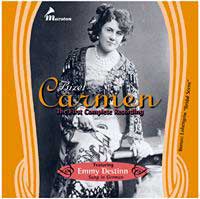 The quality of the sides varies considerably – the second entr'acte is a sonic blur, whereas the third boasts crisp tambourine accents. Clocking in at 117 minutes, about a half-hour was cut, but curiously the recitatives are left nearly whole, while paring orchestral introductions and conclusions and omitting such seemingly important portions as the second half of the "Toreador Song" and the final two notes that bring the work to a somber end. Tempos are swift, occasionally to thrilling impact (a scramble that concludes Act I and a bracing Quintet), but more often are uncomfortably rushed at the expense of the work's underlying charm. The prelude is rearranged to end with a reprise of the opening march, thus ruining the shocking silence after the original suspended dissonance (which would have been enhanced by the need to change sides – even the most adept collector would have needed ten seconds or so for that operation). The most radical adjustment, though is to the language – all the singing is in German! Perhaps it's a reflection of my indifference to the appeal of that language, but somehow "Diese Menge im Gedränge" lacks the charm of "Sur la place, chacun passe," as does "Was ist Zigeuners höchste Lust" for "Les tringles des sistres tintaient." In his notes to the Marston CD set, Harold Bruder offers that "the German language seems to sharpen the edge of the drama. While the harsh, somewhat throaty sounds lack the insinuating subtlety of the French, the opera sustains its intensity." That's certainly true of the final confrontation between Carmen and Don José, conveyed here with expressionistic emotional heat. Yet, although the rhythms of the German text fit surprisingly well, the entire conception seems somewhat removed from the linguistic values of the Opéra-Comique. The quality of the sides varies considerably – the second entr'acte is a sonic blur, whereas the third boasts crisp tambourine accents. Clocking in at 117 minutes, about a half-hour was cut, but curiously the recitatives are left nearly whole, while paring orchestral introductions and conclusions and omitting such seemingly important portions as the second half of the "Toreador Song" and the final two notes that bring the work to a somber end. Tempos are swift, occasionally to thrilling impact (a scramble that concludes Act I and a bracing Quintet), but more often are uncomfortably rushed at the expense of the work's underlying charm. The prelude is rearranged to end with a reprise of the opening march, thus ruining the shocking silence after the original suspended dissonance (which would have been enhanced by the need to change sides – even the most adept collector would have needed ten seconds or so for that operation). The most radical adjustment, though is to the language – all the singing is in German! Perhaps it's a reflection of my indifference to the appeal of that language, but somehow "Diese Menge im Gedränge" lacks the charm of "Sur la place, chacun passe," as does "Was ist Zigeuners höchste Lust" for "Les tringles des sistres tintaient." In his notes to the Marston CD set, Harold Bruder offers that "the German language seems to sharpen the edge of the drama. While the harsh, somewhat throaty sounds lack the insinuating subtlety of the French, the opera sustains its intensity." That's certainly true of the final confrontation between Carmen and Don José, conveyed here with expressionistic emotional heat. Yet, although the rhythms of the German text fit surprisingly well, the entire conception seems somewhat removed from the linguistic values of the Opéra-Comique.
Aside from an early demonstration of the international appeal of the opera and a harbinger of its extreme future adaptations, the 1908 Carmen preserves Destinn's extraordinary reading of the title role. From her first syllable, it's abundantly clear who's in charge – she constantly distends the rhythms to her dramatic needs while the orchestra scrambles to keep pace and her "Séguidille" is a command, not an invitation. Throughout, she sings in a bravura, grand manner, opting for higher alternative notes indicated in the score and adding others of her own, even at the expense of disrupting the familiar melodies, especially in the "Chanson bohème." Her headstrong personality was contagious – Jörn jacks up his final note of "Halte-la" as well. The powerful top register in which she consistently dwells paints a portrait of arrogant youth, although when she does descend into a chest voice, as in the central portion of "Mêlons! Coupons," the impact is arresting in its dark foreboding. The men sing with great authority, and Nast's ravishingly lovely voice, especially in her third act air, helps to humanize the stock character of Michaëla. Jörn and Nast meld beautifully in their first act duet to affirm an affection he would rather forget, while the roughness of the ensembles suggests spontaneity (rather than mere under-rehearsing). Beyond its historical importance and psychological insights, this first recorded Carmen attests to the centrality of the main character – and the importance of its interpreter's characterization.
- Marguerite Mérentié, Augustarello Affre, Aline Vallandri, Henry Albers, Chœurs et Orchestre du Théâtre de l'Opéra Comique Paris, François Ruhlmann (1911, Pathé, Marston CD)
Barely three years later, a second major recording was made. Today it stands as the most important Carmen document of all, as it features female leads, chorus, orchestra and conductor of the Opéra-Comique, the very institution for which Carmen had been created and whose aesthetic conventions guided its inspiration.  While 36 years had elapsed since the premiere – and, admittedly, 36 years is an artistic eon that can wield huge stylistic shifts – this set is as close as we can ever come to experiencing the original concept. The result is revelatory. Running a full 2½ hours (spread over 54 (!) original sides running from less than 2 to 3¼ minutes), it challenges our very notion of the work. Rather than a continuum of music, the set pieces are spread amid lengthy stretches of dialogue, voiced in the lightly-inflected mellifluous tradition of classical French light comedy. (Unfortunately, it's hard to know the extent of any abridgement, for lack of any standard of comparison – the score was published only with the Giuraud recitatives and reportedly even the modern Opéra-Comique uses a substantially revised text.) By studding the dialogue with musical numbers, each assumes greater intrinsic emphasis and the few extended musical sections attract natural attention without the need for exaggerated tempos, dynamics or textures. This is a team effort in which dialogue and music blend effortlessly together, shorn of raging egos. While 36 years had elapsed since the premiere – and, admittedly, 36 years is an artistic eon that can wield huge stylistic shifts – this set is as close as we can ever come to experiencing the original concept. The result is revelatory. Running a full 2½ hours (spread over 54 (!) original sides running from less than 2 to 3¼ minutes), it challenges our very notion of the work. Rather than a continuum of music, the set pieces are spread amid lengthy stretches of dialogue, voiced in the lightly-inflected mellifluous tradition of classical French light comedy. (Unfortunately, it's hard to know the extent of any abridgement, for lack of any standard of comparison – the score was published only with the Giuraud recitatives and reportedly even the modern Opéra-Comique uses a substantially revised text.) By studding the dialogue with musical numbers, each assumes greater intrinsic emphasis and the few extended musical sections attract natural attention without the need for exaggerated tempos, dynamics or textures. This is a team effort in which dialogue and music blend effortlessly together, shorn of raging egos.  (The team may have been larger than the usual opera cast – a vast audible change as Don José shifts from dialogue to his Act I duet with Michaëla suggests that separate singers and actors may have been used for the recording.) (The team may have been larger than the usual opera cast – a vast audible change as Don José shifts from dialogue to his Act I duet with Michaëla suggests that separate singers and actors may have been used for the recording.)
The sonic quality is extraordinary for its time (and undoubtedly is abetted by a superb CD transfer by Ward Marston). With only rare exceptions (i.e., one half of the divided women's chorus in "Au sécours" swamps the other), the balances are natural, all the instruments and voices are clearly heard with sufficient timbre to distinguish them, the volume of the soft parts isn't boosted (even at the expense of Michaëla's entrance being barely audible), climaxes avoid distortion, cymbals crash in the Act I finale, and sonic continuity is preserved among the discs (especially important where, as here, some songs like the "Habanera" are split over two sides). The chorus is rather scrappy (thus blurring the line between speech and song) but the children's choir in Act I sounds genuine (rather than using women, as in the 1908 set). Of the featured singers, Mérentié and Vallandri were current stars of the Opéra-Comique, while Affre and Albers specialized in French repertoire. Mérientié may not have been famous, but she presents a fine blend of delicate allure and confident power. Ruhlmann's tempos are moderate and well-judged, but with occasional appropriate adjustments (somber for the card scene, ecstatic for the "liberté" finale of Act II). We may never know how Bizet wanted his masterpiece to be heard, but this recording brings us as near as we will ever get.
- Fanny Anitua, Luigi Bolis, Ines Maria Ferraris, Cesare Formichi, La Scala Orchestra and Chorus, unidentified conductor (1920, Columbia; privately circulated digital transfer)
This final attempt to record Carmen acoustically is of nearly equal interest to the 1911 set, as it comes from arguably the most famous opera company of the time. The most heavily cut of the ostensibly “complete” early sets, its 24 sides run barely 93 minutes and curiously omit many of the most popular sections, including the opening kids’ chorus and all three orchestral entr’actes. Indeed, the emphasis clearly is on the vocals and the nameless conductor provides dutiful support for the singing (slowing down at the end of each line of the “Habanera”), without any injection of his own personality. Coming from La Scala, it preserves another important vocal tradition of the time, falling well short of verismo emotive excess yet fundamentally forceful and demonstrative. The leads apparently all were La Scala regulars. While none was known for roles in Carmen, the sheer sound of their voices fits their characters well and their smooth rapport testifies to their sublimation of individual egos to the needs of the overall ensemble. Unfortunately, the opera is sung in Italian but, unlike the German translation in the Destinn set, the rhythms tend to be awkward and ill-suited to the finely-crafted music – while the “Toreador Song” and the final dramatic duet are effective enough, the interplay of the finely-crafted music with the frequent delicate word-play (“Quand il s'agit de tromperie, de duperie, de volerie ...”) is thoroughly mangled. The recording quality is rich and nicely blended. The entire set is yet further testament to the universality of an opera that the entire world quickly embraced and made its own.
Beyond these complete recordings, we have several sets of extensive excerpts by acclaimed early interpreters of the title role.
- Emma Calvé
Emma Calvé (1858 - 1942) was
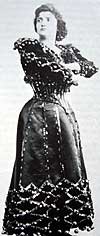
Emma Calvé as Carmen |
reputed by connoisseurs to be the greatest Carmen of them all. W. J. Henderson praised her at the time for acting with her voice and she reportedly studied gypsy dancing to assure the authenticity of her interpretation. Michael Scott calls her recorded voice "still astonishingly fresh and silvery in quality – no chesty growling nowadays thought to be seductive. … [P]ure tone, subtle teasing, rhythmic nuances vary each note." (Part of the perception of especially pure tone derives from her old style of rolling her "r"s and extremely discrete vibrato, where many modern singers try to bury infirm intonation.) She cut four Carmen pieces for Victor (now on a Romophone CD that reflects her eclectic taste that ranged from "Frère Jacques" to "La Marseillaise" and three versions of Foster's "Old Folks at Home" – all marvelous!). A 1908 "Chanson bohème" is brash, domineering and vocally colorful, with each "tra-la-la" differently shaded, no chorus to hide behind, and a lusty "olé!" shouted at the end. She recorded the "Habanera" twice, her 1916 take with piano having greater pep and rhythmic fluctuation than a 1908 record with orchestra. Perhaps most revealing is a 1907 "Là-bas dans la montagne" with tenor Charles Dalmorès, as much an example of hypnotic declamation as singing – at the conclusion time nearly stands still as she draws the final eight notes out to 34 seconds.
- Geraldine Farrar
At least in America, Geraldine Farrar (1882 – 1967) was acclaimed as the greatest Carmen of her time. Roland Vernon called her "America's dream ticket." But while much has been written about her as being beautiful, bright, vivacious, charming and youthful – the very opposite of staid European divas – curiously little is said about her singing.
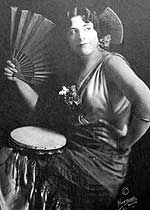
Geraldine Farrar as Carmen |
Her records help to explain why – without the theatrical trappings, little remains to merit her formidable reputation. Like Calvé, Farrar was a lyric soprano, who gladly defended her voice (and corresponding lithe physique) as fitting to create a convincing stage presence for the alluring Carmen. Apparently after her Hollywood venture in 1915-16, she became wild, picking on-stage fights with the chorus and even once reportedly slapping Caruso, all to add realistic emotions to her characterization. But her Carmen records were made the year before that, when she claimed to draw a firm line between being sensuous and vulgar – "Suggest all you will, but don't be it." She cut the major arias three weeks after her spectacular Metropolitan Opera debut in the role. They reveal a pretty, unaffected voice, neither overly polished nor especially spontaneous. Her "Habanera" is fluid, fluttery and teasing in its innocence, her "Séguidille" is delightfully casual, and her "Chanson bohème" is measured but with greater tonal depth than commentators and her other records would lead us to expect. More discs followed in May 1915. Her ominous Act III card scene has little depth but is affecting by virtue of its sheer directness. (Somewhat ironically, in 1908 she had recorded Micaëla's Act III air but sounds a bit too dark and somber for that customarily buoyant role, which she had played at the time.) A fine collection of her Carmen records on a Nimbus CD seamlessly combines four separate sides (including one unpublished) into the Act II finale and three more into the Act IV conclusion to give not only an extended glimpse into her art but an opportunity for dramatic interaction with her frequent partner, Giovanni Martinelli, who had a similarly high, clear voice. Yet, even in these highly-charged confrontations emotion never overwhelms the music – even her "Là-bas" entreaty sounds more descriptive and even mournful than inviting, much less compelling.
- Conchita Supervia
Another sensation who documented her interpretation of the title role was Conchita Supervia (1895 – 1936), whose career began and ended surprisingly early – she was starring in Carmen at age 16 and died in childbirth. Her sweeping repertoire ranged from Rossini, to which she brought an earthy coloratura, to songs and zarzuela of her native Spain. (It seems somewhat ironic that her background was thought to specially qualify her as an authentic Carmen, which, its setting aside, is a quintessentially French opera.) Her voice was unique and once heard is hard to mistake for any other.
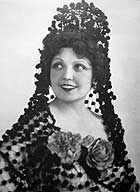
Conchita Supervia as Carmen |
As described by Desmond Shawe-Taylor, no one has ever conveyed more infectious enjoyment of the sheer act of singing – she filled each word and phrase with grace and meaning, changed mood and tone color with lightning rapidity, enlivened rhythms with warm temperament and projected a genuine, personal communicative power. Above all, she had a startlingly quick and carefully controlled vibrato, which seems to suggest complementary effects of quivering passion and stylized artifice as if to temper her direct impact with an assurance that this is really just a performance. All of this is amply evident in the ten Carmen sides she cut for Odeon (collected on a Nimbus CD) in 1930 with Gaston Micheletti as Don José (whose ardent but uninflected ringing voice is a fine match) and conductor Gustave Cloëz, which add layers of complexity to the standard approaches. There's no sense of threat in her "Habanera," but rather a vibrant and forthright invitation to adventure. Her "Séguidille" shifts from insistent command to beguiling whisper with breathtaking ease. Her "Chanson bohème" glistens throughout with youthful energy (rather than building to the end) and is spiced with rhythmically precise castinets. Her Act III Card Scene is chillingly effective, as she vocally lurks in the background after delivering her warning. The final scenes of Acts II and IV are passionate without sacrificing their purely musical values.
At the onset of each of the electrical, LP, stereo and digital eras a flood of new Carmens appeared and hasn't abated. I'll gladly leave to true fanatics any attempt to evaluate them all. Instead, I've chosen just a relative few of heightened historical significance or that have attracted a particular degree of critical notice.
- Lucy Perelli, José de Trevi, Yvonne Brothier, Louis Musy, orchestra and chorus ostensibly from the Opéra-Comique, Piero Coppola (1927, Gramophone Company, Malibran CD)
It's hard to judge the merits of this, the first electrical Carmen,

Cast and conductor of the 1927 Carmen |
since the recording is dreadful, possibly aggravated by an atrocious CD transfer (on Malibran); the result often sounds considerably worse than the 1911 acoustical set, with extremely rough side joins, volume that veers out of control, wildly inconsistent fidelity and climaxes that splatter with overload. Coppola, who led pioneering recordings of so much of the French repertoire, generally manages to keep things moving along, but not always – his tempo for the "Toreador Song" is funereal, stretching Trevi's breath beyond exhaustion. Perelli has a nice, deep mezzo voice and Brothier is nicely sweet. The others sing loud and bland, blasting out their notes with little attempt at interaction or expression. The chorus, when audible, often degenerates into a mess of confused unenthused mumbling. The liner notes are as opaque as the transfer, informing us, among other things, that "the annals are not very prolixes about Lucy Perelli's carrier." The problem of choosing between dialog or recitatives is solved by including neither, so the set pieces collide without any respite (but in fairness, playing the original 78 format would have required pauses between sides).
- Raymonde Visconti, Georges Thill, Marthe Nespoulpous, Louis Guénot, "Paris Orchestra" (reportedly the Opéra-Comique), Elie Cohen (1928, Divine Art CD)
Fortunately, the very next year a far more satisfying French Carmen appeared.
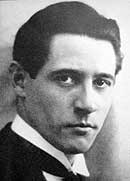
Georges Thill |
If the Coppola set was intended to perpetuate the ensemble approach of the first 1911 Opéra-Comique version, the second electrical set harks back to the 1908 venture, built around the star-power of a single artist. But unlike every other such Carmen, this one bypasses emphasis on the title role to revolve around not Carmen but Don José as the dominant interpreter. While unusual, this seems entirely appropriate – while Carmen's character remains constant, it is Don José whose degeneration is the driving force behind the narrative. Here, the star is Georges Thill, generally considered the greatest French tenor of the 20th century, and indeed he presents a convincing depiction that is both heroic and vulnerable by singing his role in a bel canto style of powerful yet tender fluid ease and extraordinary sheer musicality. Both dialogue and recitatives are omitted. The "Paris Orchestra" reportedly was the Opéra-Comique, with which the conductor and the other leads all were closely associated. While perhaps overshadowed by Thill, Visconti has a sweet but rich voice that's modest but winning, and Nespoulpous and Guénot portray their roles convincingly. The Divine Art CD restoration by Andrew Rose presents a gratifying amount of clean audio information from the original 78s.
- Instrumental Extracts and Arias
Before leaving the half-century of 78s, we should mention one further measure of Carmen’s incomparable fame – the huge number of recorded excerpts it has spawned. As would be expected, the most prevalent instrumental pieces were the free-standing prelude and entr’actes, yet the very earliest I’ve encountered is an abridgment of the “Toreador Song” issued in 1902 by the H.M. Coldstream Guards military band on a brilliant and vivid Gramophon Concert 78. Also popular were suites that comprised not only the instrumental sections but arrangements of vocal numbers. (A six-sided 1923 Odeon set by Frieder Weissmann and the Berlin State Opera Orchestra went even further by pulling in the stirring “Farandole” from Bizet’s L’ Arlesienne.) The remarkable Spanish violinist Pablo Sarasate fashioned a five-movement Carmen Fantasy showcase in 1883 that bursts with dense acrobatic embellishment of gypsy fiddling and still serves as a brilliant display vehicle for modern virtuosos. Equally alluring was a 1946 Carmen Fantasie by Franz Waxman, championed by Jascha Heifetz. Perhaps the oddest arrangement is a 40-minute Carmen Ballet by Rodion Shchedrin scored for strings and 45 percussion instruments. As for the arias themselves, the acoustic era saw recorded profusion in Italian, English, German, Russian (and, of course, the original French). While few male singers could resist the proud swagger of the “Toreador Song,” women often were drawn to the supple Habanera and Séguidille and occasionally the fiery "Chanson Boheme".

- Solange Michel, Raoul Jobin, Martha Angelici, Michel Dens, Opéra-Comique orchestra and chorus, André Cluytens (1950, Columbia, Naxos CD)
The LP era of Carmen was launched with two wonderful complete sets that remain touchstones of excellence. 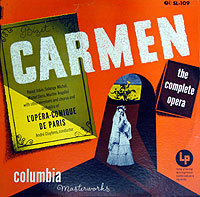 On the first, everything works beautifully and wondrously, with just enough spirit to sustain interest but without any element dominating the rest, enabling us to fully absorb the creators' masterful work without any distraction. The soloists project sufficient personality to vitalize their roles without preening for individual attention, the music is played with a sure but light touch, pacing is fleet but never rushed, enunciation clear, the monaural sound well-balanced and bright, emotions moderated but intelligible, choruses sharp and enthused but not mechanically precise, dialogue abridged and naturally conversational. No aspect stands out and some of the singing may seem somewhat bland compared to the competition, but that's really the point – above all else, there's a splendid sense of ensemble, with all forces united to contribute to a common artistic goal. My only qualms, which pale in comparison to the consistently high merits, are some blurred ensemble in the "Au sécours" double chorus and excessive stagey clomping during the "Danse bohème" (admittedly, it's a dance and not just a song, but the sound effects don't seem evocative by themselves). Overall, the spirit of light opera – and diffident French artistry – comes shining through. Everything is confidently in place without any distractions. Although I would hate to have to do it, if I ever had to choose a single favorite Carmen, this just might be it. Time and again, it fills me with appreciation for this ever-fresh masterwork. On the first, everything works beautifully and wondrously, with just enough spirit to sustain interest but without any element dominating the rest, enabling us to fully absorb the creators' masterful work without any distraction. The soloists project sufficient personality to vitalize their roles without preening for individual attention, the music is played with a sure but light touch, pacing is fleet but never rushed, enunciation clear, the monaural sound well-balanced and bright, emotions moderated but intelligible, choruses sharp and enthused but not mechanically precise, dialogue abridged and naturally conversational. No aspect stands out and some of the singing may seem somewhat bland compared to the competition, but that's really the point – above all else, there's a splendid sense of ensemble, with all forces united to contribute to a common artistic goal. My only qualms, which pale in comparison to the consistently high merits, are some blurred ensemble in the "Au sécours" double chorus and excessive stagey clomping during the "Danse bohème" (admittedly, it's a dance and not just a song, but the sound effects don't seem evocative by themselves). Overall, the spirit of light opera – and diffident French artistry – comes shining through. Everything is confidently in place without any distractions. Although I would hate to have to do it, if I ever had to choose a single favorite Carmen, this just might be it. Time and again, it fills me with appreciation for this ever-fresh masterwork.
- Risë Stevens, Jan Peerce, Licia Albanese, Robert Merrill, Metropolitan Opera Orchestra, Robert Shaw Chorale, Fritz Reiner (1950, RCA)
If Cluytens' was the quintessential French recording of Carmen, the next year produced the exemplary American version. The original LP set boasted that it was only the second opera recording made by RCA in America (and unfortunately would be among the last for two decades, although arch-rival Columbia had its own short-lived series underway). 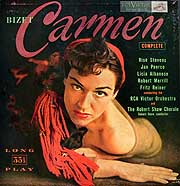 It was also on the front lines of the "speed wars" format battle, as it was issued both on three LPs and as a set of 17 45s, a throwback to the era of 78s when frequent side changes necessarily disrupted the continuity of serious compositions. (To save costs, a seven-inch square libretto suitable for packaging with the 45s rattled around inside the 12" LP box.) This was Reiner's only studio opera recording, and it's wonderful, reflecting his hallmark obsession with detail, as the orchestra vividly characterizes each phrase with expression and gives plenty of space to the singers, especially in their recitatives. The precision of the playing illustrates the same phenomenon that illuminated Toscanini's work, giving an illusion of speed even though the actual timing is quite moderate. Pronunciation is Americanized, the men verge on verismo-style bleating, Albanese seems too vibrato-laden and emphatic for an effective portrayal of her character, and Peerce sounds downright Italianate (as well as a bit brusque and charmless). Stevens is in wonderful voice – both deep and bright, equally expressive at both ends of her range. As with most recordings of the time, the balance favors the soloists at the expense of burying the orchestra during dramatic moments. Even less fortunate are dubbed crowd sounds that far exceed the size of any operatic stage. Another unique feature: in lieu of the "A deux cuartos" sequence heard in all other recordings, the Act IV ballet substitutes a "Dancez, dancez" segment and adds a wistful dance and the farandole from L'Arlesienne. Look elsewhere if you seek deference to authentic French style, but taken on its own terms, the Reiner Carmen continues the tradition of adapting the work that had begun with the very first 1908 Destinn recorded venture. It was also on the front lines of the "speed wars" format battle, as it was issued both on three LPs and as a set of 17 45s, a throwback to the era of 78s when frequent side changes necessarily disrupted the continuity of serious compositions. (To save costs, a seven-inch square libretto suitable for packaging with the 45s rattled around inside the 12" LP box.) This was Reiner's only studio opera recording, and it's wonderful, reflecting his hallmark obsession with detail, as the orchestra vividly characterizes each phrase with expression and gives plenty of space to the singers, especially in their recitatives. The precision of the playing illustrates the same phenomenon that illuminated Toscanini's work, giving an illusion of speed even though the actual timing is quite moderate. Pronunciation is Americanized, the men verge on verismo-style bleating, Albanese seems too vibrato-laden and emphatic for an effective portrayal of her character, and Peerce sounds downright Italianate (as well as a bit brusque and charmless). Stevens is in wonderful voice – both deep and bright, equally expressive at both ends of her range. As with most recordings of the time, the balance favors the soloists at the expense of burying the orchestra during dramatic moments. Even less fortunate are dubbed crowd sounds that far exceed the size of any operatic stage. Another unique feature: in lieu of the "A deux cuartos" sequence heard in all other recordings, the Act IV ballet substitutes a "Dancez, dancez" segment and adds a wistful dance and the farandole from L'Arlesienne. Look elsewhere if you seek deference to authentic French style, but taken on its own terms, the Reiner Carmen continues the tradition of adapting the work that had begun with the very first 1908 Destinn recorded venture.
- Victoria de los Angeles, Nicolai Gedda, Janine Micheau, Ernest Blanc, Orchestra and Chorus of the Radiodiffusion Française, Sir Thomas Beecham (1958, EMI/Angel)
The era of stereo Carmens began with this highly praised set.  Although English to the core, Beecham had a vast affinity for the French romantic repertoire. Here, he conceives Carmen as much as a ballet as an opera, leading with elegance and rhythmic élan. Beecham's tempos tend to be regular and leisurely, but often seem unduly slow; while this helps to create a serene aura of classical French theatre by defusing the tension, the recitatives occasionally drag and the first act José/Michaëla duet outstays its welcome. Yet Beecham gives de los Angeles plenty of room to deliver a "Habanera" drenched with attitude. Although the orchestral portions are delightful, once the solo voices enter they tend to overpower all else. Overall, Beecham's approach reminds us that Carmen can be presented as light opera – somewhat more akin to the civilized morality play that the original producers sought than Mérimée's lurid tale. Although English to the core, Beecham had a vast affinity for the French romantic repertoire. Here, he conceives Carmen as much as a ballet as an opera, leading with elegance and rhythmic élan. Beecham's tempos tend to be regular and leisurely, but often seem unduly slow; while this helps to create a serene aura of classical French theatre by defusing the tension, the recitatives occasionally drag and the first act José/Michaëla duet outstays its welcome. Yet Beecham gives de los Angeles plenty of room to deliver a "Habanera" drenched with attitude. Although the orchestral portions are delightful, once the solo voices enter they tend to overpower all else. Overall, Beecham's approach reminds us that Carmen can be presented as light opera – somewhat more akin to the civilized morality play that the original producers sought than Mérimée's lurid tale.
- Regina Resnick, Mario del Monaco, Joan Sutherland, Tom Krause, Orchestra de la Suisse Romande, Thomas Schippers (1963, Decca/London)
Of the dozens of stereos Carmens, none has been so widely slammed as this set.  Some even cite it as the worst opera recording ever made! So when I saw a nice $3 copy at Second Story, our local used book store, I just couldn't resist. Frankly, I don't see (or hear) the problem. Clearly modeled after the Reiner approach, it sounds "American" beyond the nationality of its conductor and its Carmen, and del Monaco renders a verismo Don José. It also boasts two dubious distinctions – the ugliest cover, featuring a woodcut by Bernard Buffet that depicts Carmen as a witch rather than an enchantress, and a cast list that credits the dancer responsible for the percussive clogging during the "danse bohème" (which I find annoying, along with marching feet in the Act I kids number and surging crowd noise throughout Act IV). On the plus side, Sutherland is a magnificent Michaëla, throttling down her coloratura arsenal for a sweet, fluttery, tentative characterization that inhabits the role. Resnick's deep vibrato and wide dynamic range are especially effective in quieter parts, where she exudes a tension of lurking power. The recording is rich and detailed, revealing wonderful instrumental interplay in the tender spots. I suppose I can understand why Francophiles might be appalled at the appropriation of their national treasure, but, questions of personal taste aside, don't cross-cultural efforts like this attest to the universality of Bizet's masterpiece? Some even cite it as the worst opera recording ever made! So when I saw a nice $3 copy at Second Story, our local used book store, I just couldn't resist. Frankly, I don't see (or hear) the problem. Clearly modeled after the Reiner approach, it sounds "American" beyond the nationality of its conductor and its Carmen, and del Monaco renders a verismo Don José. It also boasts two dubious distinctions – the ugliest cover, featuring a woodcut by Bernard Buffet that depicts Carmen as a witch rather than an enchantress, and a cast list that credits the dancer responsible for the percussive clogging during the "danse bohème" (which I find annoying, along with marching feet in the Act I kids number and surging crowd noise throughout Act IV). On the plus side, Sutherland is a magnificent Michaëla, throttling down her coloratura arsenal for a sweet, fluttery, tentative characterization that inhabits the role. Resnick's deep vibrato and wide dynamic range are especially effective in quieter parts, where she exudes a tension of lurking power. The recording is rich and detailed, revealing wonderful instrumental interplay in the tender spots. I suppose I can understand why Francophiles might be appalled at the appropriation of their national treasure, but, questions of personal taste aside, don't cross-cultural efforts like this attest to the universality of Bizet's masterpiece?
- Maria Callas, Nicolai Gedda, Andréa Guiot, Robert Massard, Chœurs René Duclos, Orchestre du Théâtre National de l'Opéra de Paris, Georges Prêtre (1963, EMI/Angel)
Critical reaction to this set the following year was just as consistent and intense, but far more approving.  One glance at the original LP box (or any of the CD reissues, for that matter) and it's crystal clear who's the star – this is the CALLAS Carmen, and indeed, in one of her rare forays into French opera, she dominates the entire production. Every note she sings flashes conviction in her buttery voice of startling ringing overtones that intensify her lower register – a sound as unique and unmistakable as Supervia's. When it suits her dramatic purpose, she's prepared to drip with contempt, swell with capricious power, turn vulgar, overwhelm or, in launching the "Séguidille," rework the rhythm. One glance at the original LP box (or any of the CD reissues, for that matter) and it's crystal clear who's the star – this is the CALLAS Carmen, and indeed, in one of her rare forays into French opera, she dominates the entire production. Every note she sings flashes conviction in her buttery voice of startling ringing overtones that intensify her lower register – a sound as unique and unmistakable as Supervia's. When it suits her dramatic purpose, she's prepared to drip with contempt, swell with capricious power, turn vulgar, overwhelm or, in launching the "Séguidille," rework the rhythm. 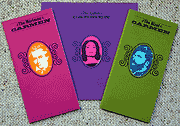 Hers is a complex character, but always larger than life (although, curiously, it's a role she never sang on stage). Pretre leads a well-paced performance, and the others tend to darken their own voices to blend well with the Callas-led conception, both in duets and ensembles. As if to emphasize the import of this production (and its driving purpose), the original Angel LP box contained three booklets of profuse documentation – not only the full libretto (titled "The Bizet Carmen") but the full Mérimée novella ("The Mérimée Carmen"), both printed in a 6 x 12 format and dwarfed by a full-sized 12 x 12 booklet entitled "The Callas Carmen" with lots of photos of the production, kudos for its superstar and, just in case the point was too subtle, text that begins: "Callas is Carmen." Hers is a complex character, but always larger than life (although, curiously, it's a role she never sang on stage). Pretre leads a well-paced performance, and the others tend to darken their own voices to blend well with the Callas-led conception, both in duets and ensembles. As if to emphasize the import of this production (and its driving purpose), the original Angel LP box contained three booklets of profuse documentation – not only the full libretto (titled "The Bizet Carmen") but the full Mérimée novella ("The Mérimée Carmen"), both printed in a 6 x 12 format and dwarfed by a full-sized 12 x 12 booklet entitled "The Callas Carmen" with lots of photos of the production, kudos for its superstar and, just in case the point was too subtle, text that begins: "Callas is Carmen."
- Leontyne Price, Franco Corelli, Mirella Freni, Robert Merrill, Vienna State Opera Chorus, Vienna Philharmonic, Herbert von Karajan (1963, RCA Soria)
If the EMI set was the Callas Carmen, then this is von Karajan's. Not only the instrumental interludes but the entire opera dwells in symphonic textures and thus affords a welcome opportunity to revel in Bizet's sensitivity to orchestration, from the rich, commanding statement of the fate motif in the prelude to the enrichment of Don José's concluding confession as the orchestra swells and overwhelms his final word, as if to affirm that fate itself can never be ignored. 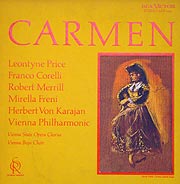 Of course, it helps to have the Vienna Philharmonic as a colleague in such a venture. Karajan's generally deliberate pacing tends to underline the narrative's serious undercurrent, and not always for the best – while distending the ominous opening scene of Act III is especially effective, the rest of that act does tend to drag. Perhaps in deference to the orchestra, the voices tend to lack character, as if they were just another element in the musical mix, and much of the singing is attenuated (including an especially effective "La cloche a sonné" that's nearly whispered and paves the way for the men's outburst demanding Carmen). Even so, for all the careful grooming there's an overall lack of charm – even the kids' chorus, usually guaranteed to exude genuine warmth, seems damagingly clipped and militaristic. Price is an alluring Carmen who tempers her rich, fluid voice to create considerable tension and to magnify the impact of the few times when she does cut loose, as at the end of the "Séguidille." Exaggerated stereo effects enable vocal lines that often are buried to emerge, as in the Act II quintet and an "au sécours," that sounds like a real verbal battle of opposites rather than a mere clever choral exercise. Yet, the characters constantly move from one speaker to the other, which occasionally is effective (as when the kids march on and off) but often seems senseless and confusing without stage action. (Curiously, though, all three women are clustered at the left during the entire card scene, which may reflect the staging of a theatrical presentation but seems to miss an opportunity on records to spatially differentiate their lines.) The original LP issue boasted the deluxe packaging and lavish brochure of RCA's Soria series, a sad reminder in our days of puny CD documentation of the impact of larger-scale presentation. Of course, it helps to have the Vienna Philharmonic as a colleague in such a venture. Karajan's generally deliberate pacing tends to underline the narrative's serious undercurrent, and not always for the best – while distending the ominous opening scene of Act III is especially effective, the rest of that act does tend to drag. Perhaps in deference to the orchestra, the voices tend to lack character, as if they were just another element in the musical mix, and much of the singing is attenuated (including an especially effective "La cloche a sonné" that's nearly whispered and paves the way for the men's outburst demanding Carmen). Even so, for all the careful grooming there's an overall lack of charm – even the kids' chorus, usually guaranteed to exude genuine warmth, seems damagingly clipped and militaristic. Price is an alluring Carmen who tempers her rich, fluid voice to create considerable tension and to magnify the impact of the few times when she does cut loose, as at the end of the "Séguidille." Exaggerated stereo effects enable vocal lines that often are buried to emerge, as in the Act II quintet and an "au sécours," that sounds like a real verbal battle of opposites rather than a mere clever choral exercise. Yet, the characters constantly move from one speaker to the other, which occasionally is effective (as when the kids march on and off) but often seems senseless and confusing without stage action. (Curiously, though, all three women are clustered at the left during the entire card scene, which may reflect the staging of a theatrical presentation but seems to miss an opportunity on records to spatially differentiate their lines.) The original LP issue boasted the deluxe packaging and lavish brochure of RCA's Soria series, a sad reminder in our days of puny CD documentation of the impact of larger-scale presentation.
- Marilyn Horne, James McCracken, Adriana Maliponte, Tom Krause, Metropolitan Opera Chorus and Orchestra, Leonard Bernstein (1973, DG)
This 1973 Metropolitan Opera recording was hailed as the first in two decades to have been made in America; since the RCA and Columbia series of the early '50s (including the Reiner Carmen), operas (and even most choral work) had emigrated to Europe to avoid union costs. 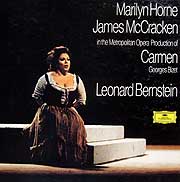 Bernstein's label, Columbia, declined to record it but gave Bernstein a release so he could take the project elsewhere. Deutsche Grammophon Gesellschaft (DG), the German affiliate of the huge Philips/Polydor complex, was willing to commit the necessary resources, not only to the recording but also to lavish presentation and marketing. It turned out to be a wise investment, as the Bernstein/Met Carmen became the best-selling opera in the entire DG catalogue. Both the playing and recording are full-blooded yet finely-detailed. The leads all sing with sensitivity and discretion and beyond a few outbursts Horne is enticing and sensual. The voices are convincingly nestled within the orchestral texture rather than constantly battling to override it. In lieu of the usual sung recitative, just enough dialog is included to separate the musical numbers without attempting to replicate the full narrative theatrical experience. Any sense of discontinuity is mitigated by overlapping the spoken segments with the adjacent music. Yet the declamation is pointedly inflected with little regard for the traditional French style. Bernstein's pacing is generally deliberate, infusing the entire tale with forebodings of tragedy, yet bursting with fits of animation that are mostly invigorating but occasionally ridiculous, including a first-act "Au sécours" that sounds more like a riot than a scuffle, Carmen throwing a full-blown hissy-fit when she can't find her castinets in Act III, and heaving Don José's ring at the end with a blood-curdling grunt worthy of an Olympic shot-putter. While his realization is vivid, moving and lots of fun, Bernstein reaches for the sky but breaks through the delicate glass ceiling of stylized French opera. History aside, critics praised Leonard Bernstein for a conception of stark realism; the New York Times called it "daring and provocative," "a brilliant conception" and "the most interesting performance at the [Met] in our time." Bernstein's label, Columbia, declined to record it but gave Bernstein a release so he could take the project elsewhere. Deutsche Grammophon Gesellschaft (DG), the German affiliate of the huge Philips/Polydor complex, was willing to commit the necessary resources, not only to the recording but also to lavish presentation and marketing. It turned out to be a wise investment, as the Bernstein/Met Carmen became the best-selling opera in the entire DG catalogue. Both the playing and recording are full-blooded yet finely-detailed. The leads all sing with sensitivity and discretion and beyond a few outbursts Horne is enticing and sensual. The voices are convincingly nestled within the orchestral texture rather than constantly battling to override it. In lieu of the usual sung recitative, just enough dialog is included to separate the musical numbers without attempting to replicate the full narrative theatrical experience. Any sense of discontinuity is mitigated by overlapping the spoken segments with the adjacent music. Yet the declamation is pointedly inflected with little regard for the traditional French style. Bernstein's pacing is generally deliberate, infusing the entire tale with forebodings of tragedy, yet bursting with fits of animation that are mostly invigorating but occasionally ridiculous, including a first-act "Au sécours" that sounds more like a riot than a scuffle, Carmen throwing a full-blown hissy-fit when she can't find her castinets in Act III, and heaving Don José's ring at the end with a blood-curdling grunt worthy of an Olympic shot-putter. While his realization is vivid, moving and lots of fun, Bernstein reaches for the sky but breaks through the delicate glass ceiling of stylized French opera. History aside, critics praised Leonard Bernstein for a conception of stark realism; the New York Times called it "daring and provocative," "a brilliant conception" and "the most interesting performance at the [Met] in our time."
- Tatiana Troyanos, Plácido Domingo, Kiri Te Kanawa, José van Dam, the John Aldis Choir, London Philharmonic, Georg Solti (1975, Decca/London)
1975 saw another significant performance. Troyanos is an especially alluring Carmen, often barely rising above a whisper, but the real distinction lies in Solti's fresh look at the music, reflecting the then-recent discovery and publication by Fritz Oeser of the score and parts used for the premiere, which reveal many differences with the standard materials and even the first vocal score which Bizet is known to have supervised and that is thought to represent the opera as first performed. 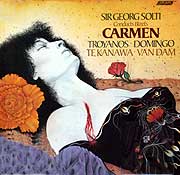 In their detailed album notes, both Solti and Winton Dean contend that while handwritten revisions were made or authorized by Bizet in preparing the work for performance, his outright cuts can be ambiguous – Bizet was known for condensing his material as he developed it, yet he may have been pressured by producers or artists to shorten or simplify his conception despite his artistic instincts. Solti had presented the entire Oeser version at Covent Garden in 1967, but was more selective for his recording. In his LP notes, Solti reviews each of the 18 major differences and details his reasons for accepting only eight and disregarding the others as musically or dramatically weak. Those he includes are a mischievous canon while Don José quizzes an officer about the factory girls (also used by Bernstein in his recording), a lovely extended verse in the "La cloche a sonné" chorale, a respite during the "Au sécours" fight in which Carmen's theme tellingly appears, four lines added to "Vivat le torero!," Carmen cruelly mocking Don José with his own words and melody after his "La fleur que tu m'avais jetée" plea, an extended Act II finale affording a welcome opportunity to hear more of the rousing but all too brief ode to liberty, an evocative horn call and answer to begin Act III in rusticity, and a longer Act III fight in which a magnanimous Escamillo at first bests Don José but spares his life, thus glaring a far harsher light on Don José's subsequent effort to kill his rival before Carmen intervenes. Solti aptly concludes his notes by cautioning against concern over the disputed modifications getting out of proportion, as the divergent details are minor and leave the glorious basic conception intact. In their detailed album notes, both Solti and Winton Dean contend that while handwritten revisions were made or authorized by Bizet in preparing the work for performance, his outright cuts can be ambiguous – Bizet was known for condensing his material as he developed it, yet he may have been pressured by producers or artists to shorten or simplify his conception despite his artistic instincts. Solti had presented the entire Oeser version at Covent Garden in 1967, but was more selective for his recording. In his LP notes, Solti reviews each of the 18 major differences and details his reasons for accepting only eight and disregarding the others as musically or dramatically weak. Those he includes are a mischievous canon while Don José quizzes an officer about the factory girls (also used by Bernstein in his recording), a lovely extended verse in the "La cloche a sonné" chorale, a respite during the "Au sécours" fight in which Carmen's theme tellingly appears, four lines added to "Vivat le torero!," Carmen cruelly mocking Don José with his own words and melody after his "La fleur que tu m'avais jetée" plea, an extended Act II finale affording a welcome opportunity to hear more of the rousing but all too brief ode to liberty, an evocative horn call and answer to begin Act III in rusticity, and a longer Act III fight in which a magnanimous Escamillo at first bests Don José but spares his life, thus glaring a far harsher light on Don José's subsequent effort to kill his rival before Carmen intervenes. Solti aptly concludes his notes by cautioning against concern over the disputed modifications getting out of proportion, as the divergent details are minor and leave the glorious basic conception intact.
My apologies to all whose favorite Carmen I've ignored, but the sheer number of fine recordings is simply overwhelming. My overview is not intended as a definitive list of "the best." Rather, I wanted to focus on those that seemed to have the strongest claim for historical or cultural importance.
The factual information in this article was based primarily upon the following books and liner notes to LPs and CDs:
- Bleiler, Ellen: Carmen (Dover, 1970)
- Dean, Winton: Bizet (J. M. Dent & Sons, 1948)
- McClary, Susan: articles in Peter Robinson: Carmen - Cambridge Opera Handbook (Cambridge, 1992)
- Parker, D. C.: Georges Bizet - His Life and Work (Harper, 1926)
- Baxter, Robert - notes to Carmen (1911 Pathé) - Marston 52019
- Bruder, Harold - notes to Carmen (1908 G&T) - Marston 52022
- Chavez, Quita - notes to Carmen (Schippers, 1963) - London OSA 1368
- Dean, Winton and George Solti - notes to Carmen (1973 Solti) - London OSA-13115
- Shawe-Taylor, Desmond - notes to Supervia in Opera and Song - Nimbus 7836/7
- Steane, John - notes to Emma Calvé - the Complete Victor Recordings - Romophone 81024
- Vernon, Richard - notes to Farrar in French Opera - Nimbus 7824
A seemingly comprehensive listing of Carmen recordings (200+ so far!), together with their casts and original and reissue release and review data, is currently online at the remarkable Operadis website.

Copyright 2014 by Peter Gutmann
|
